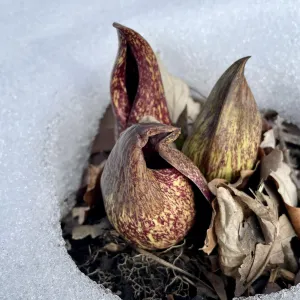Plant Pick: Skunk Cabbage (Symplocarpus foetidus)
with Manager of Living Collections Elaine Chittenden

Published May 28, 2024
Leaflet 2023
Oh, the glory of spring in New England, and the perennial bloom of the earliest native plant: skunk cabbage! Also known as swamp cabbage, polecat weed and fetid pothos, this plant is celebratory for those who seek it out along wet woods, swamps, streams, or otherwise shady seepage areas as early as March in southern New England. The species can be found from Tennessee to northern Canada.
Skunk cabbage is a member of the Araceae, aroid or arum family, which includes houseplants such as the peace lily (Spathiphyllum), calla lily (Calla) and flamingo lily (Anthurium), none of which are true lilies, and philodendron, which is both a common name for a familiar houseplant and the genus that these plants belong to. The Araceae family contains well over 105 genera, with more than 4,000 species, mostly from tropical and subtropical environments. They range in size from the smallest flowering plants known, duck weeds and watermeal (Lemna and Wolffia), to the plant with the largest unbranched inflorescence in the world, the titan arum (Amorphophallus titanum).

Apart from the duckweeds, most aroids feature a spike-like inflorescence known as a spadix, and a sheathing leaflike bract called a spathe. The bloom of skunk cabbage includes a short- stalked, cream- to maroon-colored knoblike spadix nestled within a spongy, hood-like maroon spathe, often streaked or mottled yellow, which looks more like a botanical bivalve than a flower. Skunk cabbage flowers display an amazing biological phenomenon: thermogenesis. The spadix produces its own heat, reaching temperatures up to 20°C (36°F) warmer than the outside air temperature. It does this by burning starch from its massive root system, day and night, for a period of 12 to 14 days. This heat melts any snow or ice covering the skunk cabbage in the early spring.
The heat produced by the spathe also wafts the skunky odor these flowers emit, caused by the aptly named chemicals putrescine and cadaverine. The chemicals attract the skunk cabbage’s pollinators, including gnats, carrion flies and beetles. Honeybees also find early pollen on skunk cabbage flowers and opportunist spiders may spin a web across the opening of the spathe to catch would-be pollinators looking for a warm place.
It is only after these bizarre blooms melt through the snow that the plants unfurl their leaves. Spear-shaped vegetative buds produce bright-green funnel-shaped rosettes of leaves with elongating petioles emerging from each plant’s underground rhizome. As the flowers set fruit, the spadix is transformed into what looks like a greenish-black grenade at the base of the rosettes. Populations can contain hundreds of plants and resemble a sea of common Hosta. By mid-July to mid-August the leaves wither and there may be evidence of bird or small mammal predation on the fruits.
Symplocarpus means connected fruits—the fruit morphology of skunk cabbage resembles a pineapple—but no part of this plant should ever be consumed fresh as it can be fatal; plants of this species and many other aroids are full of microscopic calcium oxalate crystals which deter nibbling. Even small doses of these irritating crystals can cause intense mouth and throat pain and swelling in the airway. Wild-food foragers harvest unfurling skunk cabbage leaves under 8 inches long and boil them for at least five minutes, using four changes of water, to dissolve and rinse away the calcium oxalate crystals in order to render the plant edible.
Skunk cabbage can be easily propagated by seed. Each fruit can contain over 50 chickpea-sized dull yellow to purple-streaked seeds. Seeds must be planted soon after harvesting or stored moist in a refrigerator to preserve viability. Symplocarpus foetidus is one species we regularly offer in Index Seminum, the international seed exchange program for botanic gardens. The species is always highly requested by other gardens.